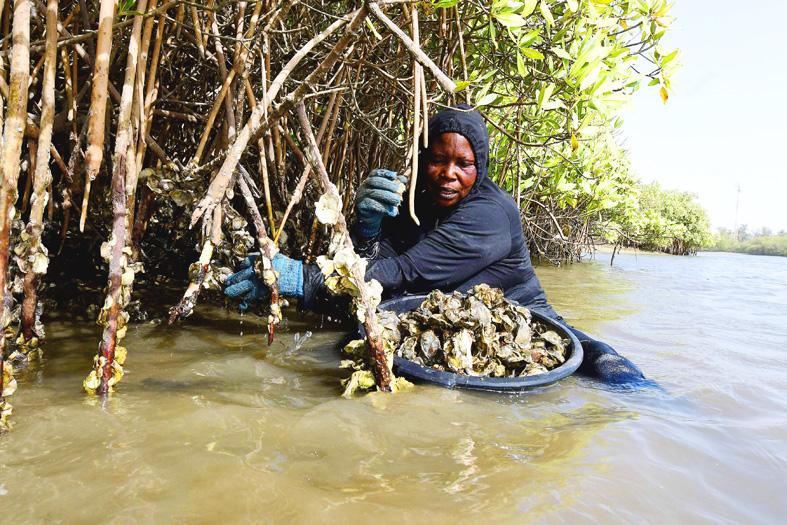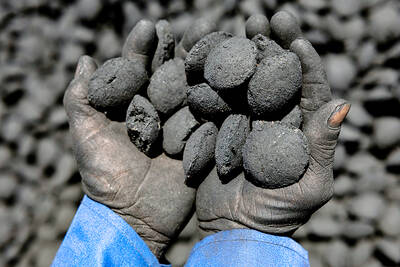The mangrove swamp near Joal-Fadiouth, a fishing village in southern Senegal, teems with oysters, but hunting for shellfish treasure among gnarly tree roots in brackish water is a lot of work.
Thousands of people — the vast majority of them women — make a living from oysters in Senegal, usually at a small and informal level.
However, experts say the tropical West African state has huge prospects for ramping up oyster output to far greater levels.

Photo: AFP
“Oyster production is falling short of its potential,” said Boubacar Banda Diop, in charge of the oyster sector at the Senegalese Ministry of Fisheries and Maritime Economy.
The possible harvest, in terms of protein and money, could be high, champions of the oyster say.
About 40 percent of Senegal’s population of 17 million people live below the poverty line, according to a World Bank metric. In a nation where fish is a traditional staple, the country also suffers from overfishing and food insecurity.
In 2017, farmers plucked about 15,600 tonnes of oysters from Senegal’s mangroves, according to the UN Food and Agriculture Organization (FAO). They also gathered about 400 tonnes from oyster beds.
By comparison, the world’s largest oyster producer, China, harvests about 3.5 million tonnes per year, according to the French research institute Ifremer.
Senegal’s government has a development plan for the oyster industry, while the FAO and the EU are putting forward ideas for techniques and breeding programs to enhance production.
A small business in the Somone Lagoon south of Dakar has already begun to apply some of the project’s recommendations.
“We have doubled our production capacity compared to last year, going from 3 to 6 tonnes per year,” the head of the business, Khadim Tine, told reporters.
However, such successes are rare — and the hurdles for those who want to make the jump from artisanal to industrial-scale farming are daunting.
Mamadou Bakhoum, the head of an association of villages in southern Senegal, said high water salinity caused by climate change meant there were fewer oysters than before.
However, “if people get serious about it, the potential for developing oyster farming is enormous,” he said.
Increasing the productivity of oyster farming while protecting Senegal’s mangroves poses another environmental challenge. The habitat features plants and shrubs growing in shallow semi-salty water, protecting against coastal erosion, and nurturing a complex and invaluable ecosystem. Mangroves are already under increasing threat in Senegal, as elsewhere.
Abdou Karim Sall, president of the Joal-Fadiouth Marine Protected Area, aims to help farmers cultivate oysters without spoiling the mangroves. Wooden trestles are placed in the swamp with wires hanging between supports just above the waterline. Spats — strings of oyster larvae that grow into the shellfish — then begin to develop on the wires.
Sall said the method protects the mangrove, but also allows the farmers to produce more oysters and earn more money.
Local non-governmental organizations in Joal-Fadiouth have helped several women oyster farmers to start using the technique.
Selling oysters fresh — as opposed to cooked, as is usual in Senegal — could also boost returns for farmers. Industry figures say that a dozen fresh Senegalese oysters sell for the equivalent of 7 to 9 euros (US$7.57 to US$9.73).
That is a price that puts fresh oysters way of out of reach for many in the country — wealthy tourists would be the target market for an expanded industry. To meet it would problems are cold storage, transport infrastructure and sanitation standards.
Expanding the oyster business to an industrial scale requires systems to monitor water quality, as oyster farms are prone to contamination. For water quality alone, a budget of about 305,000 euros would be needed for the first decade, the ministry said — a big ask in a developing country.

DIVIDED VIEWS: Although the Fed agreed on holding rates steady, some officials see no rate cuts for this year, while 10 policymakers foresee two or more cuts There are a lot of unknowns about the outlook for the economy and interest rates, but US Federal Reserve Chair Jerome Powell signaled at least one thing seems certain: Higher prices are coming. Fed policymakers voted unanimously to hold interest rates steady at a range of 4.25 percent to 4.50 percent for a fourth straight meeting on Wednesday, as they await clarity on whether tariffs would leave a one-time or more lasting mark on inflation. Powell said it is still unclear how much of the bill would fall on the shoulders of consumers, but he expects to learn more about tariffs

NOT JUSTIFIED: The bank’s governor said there would only be a rate cut if inflation falls below 1.5% and economic conditions deteriorate, which have not been detected The central bank yesterday kept its key interest rates unchanged for a fifth consecutive quarter, aligning with market expectations, while slightly lowering its inflation outlook amid signs of cooling price pressures. The move came after the US Federal Reserve held rates steady overnight, despite pressure from US President Donald Trump to cut borrowing costs. Central bank board members unanimously voted to maintain the discount rate at 2 percent, the secured loan rate at 2.375 percent and the overnight lending rate at 4.25 percent. “We consider the policy decision appropriate, although it suggests tightening leaning after factoring in slackening inflation and stable GDP growth,”

Meta Platforms Inc offered US$100 million bonuses to OpenAI employees in an unsuccessful bid to poach the ChatGPT maker’s talent and strengthen its own generative artificial intelligence (AI) teams, OpenAI CEO Sam Altman has said. Facebook’s parent company — a competitor of OpenAI — also offered “giant” annual salaries exceeding US$100 million to OpenAI staffers, Altman said in an interview on the Uncapped with Jack Altman podcast released on Tuesday. “It is crazy,” Sam Altman told his brother Jack in the interview. “I’m really happy that at least so far none of our best people have decided to take them

As they zigzagged from one machine to another in the searing African sun, the workers were covered in black soot. However, the charcoal they were making is known as “green,” and backers hope it can save impoverished Chad from rampant deforestation. Chad, a vast, landlocked country of 19 million people perched at the crossroads of north and central Africa, is steadily turning to desert. It has lost more than 90 percent of its forest cover since the 1970s, hit by climate change and overexploitation of trees for household uses such as cooking, officials say. “Green charcoal” aims to protect what